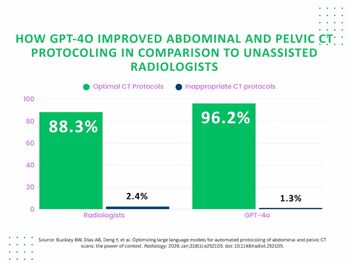Adding a new 4X assessment category in lung CT screening reports for lesions suspicious for malignancies allows experienced radiologists to detect more malignancies, according to a study published in the journal Radiology. Using the National Lung Cancer Trial database, researchers from the Netherlands, Korea, Italy, and Austria sought to determine the added value of Lung CT Screening Reporting and Data System (Lung-RADS) assessment category 4X over categories 3, 4A, and 4B for differentiating between benign and malignant sub-solid nodules (SSNs). 4X was a recently introduced category. The researchers searched for baseline CT scans that were classified as Lung-RADS category 3 or higher. They identified 374 SSNs for analysis. One experienced screening radiologist volumetrically segmented all solid cores and located all malignant SSNs visible on baseline scans. Six experienced chest radiologists independently determined which nodules to upgrade to category 4X, and they compared malignancy rates of purely size-based categories and category 4X. The researchers also calculated false-positive rates of category 4X lesions. The results showed that 15 percent to 24 percent of the SSNs were upgraded to category 4X. The malignancy rate for 4X nodules varied from 46 percent to 57 percent per observer and was substantially higher than the malignancy rates of categories 3, 4A, and 4B SSNs without observer intervention (9 percent, 19 percent, and 23 percent, respectively). The false-positive rate for category 4X nodules was an average of 7 percent for category 3 SSNs, 7 percent for category 4A SSNs, and 19 percent for category 4B SSNs. Of the falsely upgraded benign lesions, on average 27 percent were transient. The agreement among the observers was moderate. The researchers concluded experienced radiologists can find more malignancies with a new 4X assessment category in a nodule management tool. Proof of the transient character of category 4X lesions at short-term follow-up could avoid unnecessary invasive management.





























